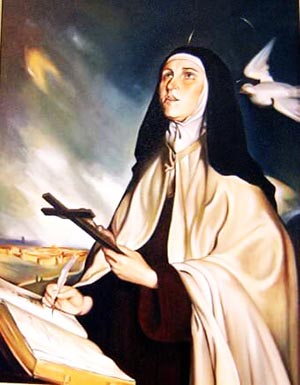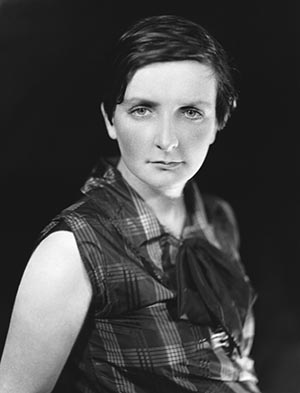Teresa of Ávila lived at a time when women had two paths: the invisibility of the convent or the service to husband, house and children, but she did not resign herself to that predetermined destiny.
At that time, culture was placed on the highest shelves of life, women were forbidden to use ladders to reach it, therefore most of them remained illiterate.
Teresa learned reading and writing because she was from a wealthy family and her mother taught her. She read poetry, the lives of saints and books of chivalry. At the age of twenty, she ran away from home to be a nun and entered the convent of the Incarnation, where the customs were so frivolous that, after some years, tired of emptiness, she decided to reform the “Carmelite Orders”. Approximately forty poems, several books, many letters, and a lot of convent foundations are attributed to Teresa. Nowadays we would consider her a great businesswoman, although her objectives were not economic, but spiritual.
Kate O'Brien lived at a time when women could already go to university and work outside the home. She graduated from University College Dublin, then travelled to the UK where she worked as a journalist. In 1922, when she was 25 years old, she went to Bilbao to teach English to the children of a prosperous Basque family. Kate was fascinated by Spain from the first moment, especially by the contrast of the landscapes: the woods of the north and the austerity of Castile served as inspiration for many of her works such as Mary Lavelle (1936) where she describes the life of Bilbao in the twenties and the passion of the protagonist with a married man. "Farewell Spain" (1937) essay that narrates her travels and nostalgic impressions through Spain, she also praises the Second Republic and she regrets that “Frente Popular” didn´t have enough time to carry out its political projects because of the coup perpetrated by Franco. "That Lady" (1946) is a historical novel about the princess of Éboli.
Kate began to read St. Teresa in 1934, which shows that her level of the Spanish language was remarkably high since St. Teresa's books were informal and easy to read for her contemporaries but very difficult for a modern reader or a foreigner. Kate not only read the great mystic woman, but she also wrote about her in "Teresa of Ávila", in 1951, a small but intense biography whose objective was that English speakers had the opportunity to know the exceptionality of Saint Teresa. In the first chapter, she says:
” I write of Teresa of Ávila by choice, which is passionate, arbitrary, personal. No one needs to agree with anything I have to say but they must not, either, be hurt thereby. I am free here to speak freely about a great woman. But I am not writing of the canonized saint. I propose to examine Teresa, not by the rules of canonization, but for what she was -saint or not- a woman of genius”
She compares her to Dante when she describes hell and to Wordsworth when she describes ecstasy, "the suspension of the senses or the flight of the spirit." Kate O'Brien emphasizes the complicity and humorous dialogue between God and Teresa as she tries to present God as a trusted friend who can be played jokes, not the egocentric tyrant of the Old Testament who releases an eternal punishment for a tiny sin. An example is when St. Teresa complains to God about the harsh treatment and difficult tests she has to undergo and the Lord answers: "thus do I treat my friends". To which Teresa replied: “for this reason, Thou hast very few.”
Apart from these books related to Spain, Kate wrote many others, eleven novels in total, essays, plays, newspaper columns...
Both Teresa and Kate had major obstacles in their respective lives. Teresa was hounded by the Inquisition. In fact, the court of Seville interrogated her for two fundamental reasons: her Jewish origin and her fondness for writing, since she was a woman, and this vocation was reserved for men only. However, Teresa did not give up, clever and shrewd, she justified herself by saying that her confessor had asked her to write in order to teach other nuns how they should pray and, from time to time, in her texts she introduced an apology: "of these matters, wise men should write and not me who I am a woman and a worthless one”, thus she avoided censorship. Teresa did not resign herself to the mandates of her time, she went off the predestined way for any woman, looking for "The way of perfection", she did not allow anyone to write her destiny, she took quill and paper and wrote "The book of my life" and she did not worry whether she lived among fleas or gold, she chose "The interior castle".
For her part, Kate O'Brien was also censured in both Spain and Ireland, as she had the courage to criticize Franco's dictatorship. In addition to her political stance, Kate was attacked and rejected for her homosexuality.
The fact is that some books by Kate O'Brien were banned in both countries, and she was prevented from entering Spain, a ban that lasted until 1957. This Irish writer loved Ávila. She used to stay in the “Hotel Jardín”, today “Puerta del Alcázar” and she loved walking through those places that had a great link with Saint Teresa. On the initiative of José Antonio Sierra, the first director of the Instituto Cervantes in Dublin, Gotarrendura, (village where Teresa is said to be born) and Ávila dedicated one of their streets to Kate, so that we won´t forget about her.
Teresa and Kate met in books, those magical objects that transport us to other times when we meet new friends. They taught, by their example, how to overcome obstacles with courage. Teresa and Kate are admired for having left a work of mperishable quality, but they are also an inspiration as an example of struggle.
(Enviado por José Antonio Sierra)




















 Si (
Si ( No(
No(






